
Tissue Reconstruction in Long Island, NY
Click above to see reviews.
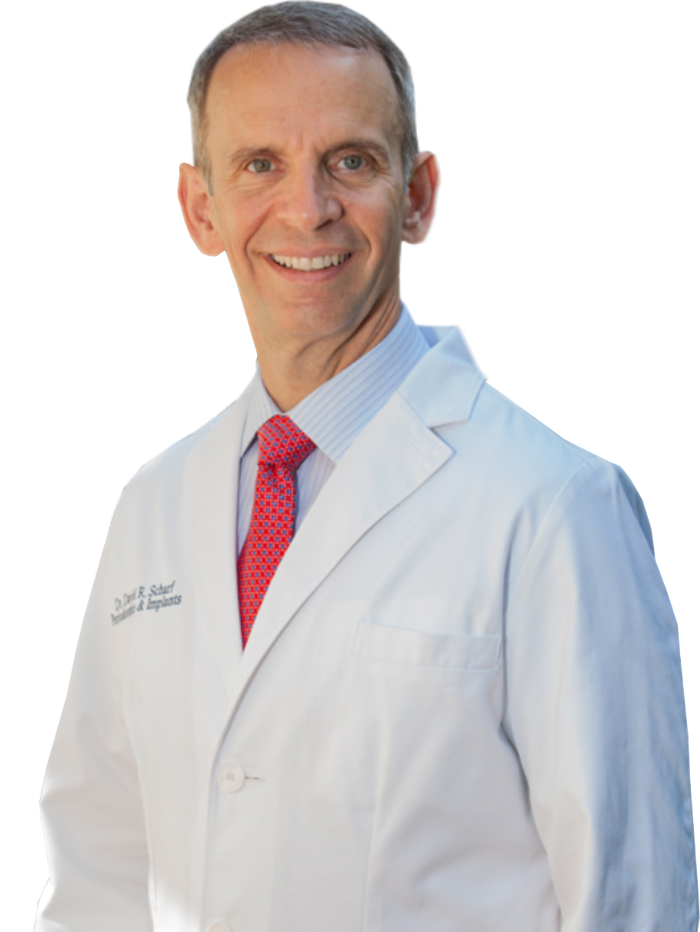

Hard Tissue Reconstruction
Your teeth and jaw each rely on the other to stay healthy and strong. While your jaw provides structure and support for your teeth, your teeth provide stimulation to your jawbone when you talk and chew. When teeth fall out and aren’t replaced immediately with an implant, the jawbone doesn’t receive stimulation, and will start to melt away, or resorb. Jaw bone can also resorb if you have been wearing removable dentures for a long time, or if the fit of your denture or bridge isn’t quite right.
The resorption process occurs more rapidly than most people realize. In fact, when a tooth is lost, the surrounding bone can lose as much as 25% of its ridge height within the first year, and then continue to lose an additional 4 millimeters of height within the next few years.
In addition to affecting the shape of your jaw and the contours of your face, shrunken bone tissue can also make it hard to place dental implants. To correct this problem, Dr. Scharf may recommend hard tissue reconstruction, also called bone grafting.
Hard Tissue Reconstruction: An Overview
Although hard tissue reconstruction can sound intimidating, most people report that it feels just like any other dental or periodontal treatment. After the area has been carefully evaluated and X-rays have shown the extent of your bone resorption, Dr. Scharf will use bone material or bone substitutes to stimulate bone growth and to rebuild the area. After the grafts have been placed, the space will need some time to heal. Depending on the condition of your teeth, gums, and jaw tissue, this may take anywhere from 6-9 months. However, after the area has healed, it will be strong and durable enough to support a beautiful, stable implant.
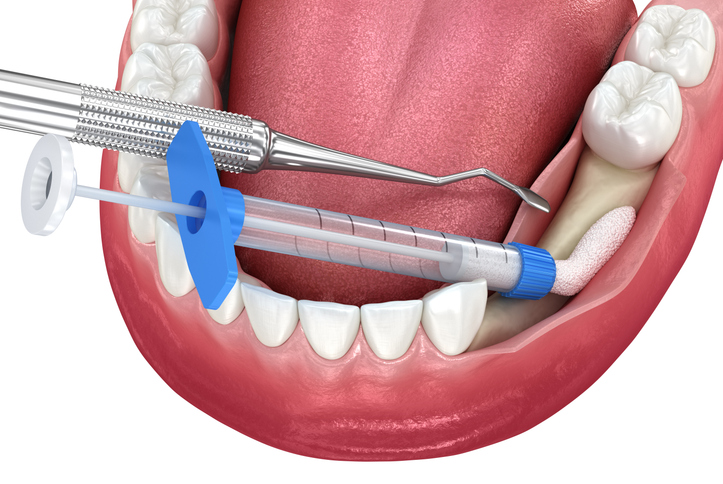

Recovering From Hard Tissue Reconstruction
For the first 24-48 hours following hard tissue reconstruction, the area may ooze or bleed slightly, and some patients experience swelling. To minimize the risk of unintentionally dislodging bone particles, do not disturb the wound and avoid rinsing your mouth vigorously. Patients recovering from hard tissue reconstruction should also avoid smoking, which can interfere with healing, and drinking alcohol, which can dry out the mouth and cause pain.
To reduce pain and swelling, patients are encouraged to use ice packs on the outside of the face near the grafting site and to take their prescribed medications on time. Over-the-counter pain medications like Tylenol and Ibuprofen can help patients to control pain and reduce swelling.
For the first day following hard tissue reconstruction, patients should ingest liquids but avoid straws, which can dislodge protective blood clots. After the first day, patients can enjoy soft foods until they feel comfortable eating a normal diet. Until your wound site has healed, you may need to chew foods on the opposing side of your mouth.
Sutures are removed at a follow-up appointment 7-10 days following the procedure, and your healing will be monitored closely by Dr. Scharf throughout the next several months.
Soft Tissue Reconstruction
Gum or Gingival Grafting
A gum graft, or gingival graft, is done when a tooth or implant is missing the tough pink tissue that normally surrounds and protects the teeth. In such cases, more gum tissue can be added to an area that is deficient. The donor tissue can be taken from the palate, or artificial tissue can be used. Dr. Scharf uses a technique called “connective tissue grafting,” which greatly reduces the pain and bleeding normally associated with gum grafts from the palate, allowing patients to experience great results with a minimum of pain and healing time.
Here is a case of gingival grafting treated by Dr. Scharf:
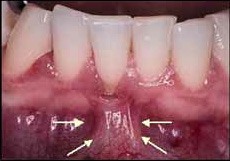
This tooth had no attached gingiva (the tissue that forms a tough, resistant seal against the root of the tooth). The gum tissue was pulling away from the tooth, making the gum line sore and difficult to keep clean.
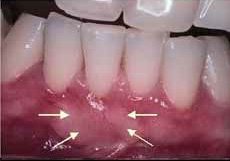
A gingival graft was used to transplant gum tissue from the roof of the mouth. The new tissue blends in beautifully and forms a durable, protective seal against the root of the tooth. This tooth now has an excellent chance of staying healthy for years to come.
Frenectomy Surgery
The frenum is the small piece of tissue that attaches at one end to the lips and at the other end to the gums. It serves no purpose and contains no muscle fibers. Sometimes the frenum connects too close to the teeth and gets in the way of effective oral hygiene. In severe cases, it can even compromise the seal of the gum tissue to the teeth. When this occurs, a simple frenectomy surgery can be done to eliminate the problem. In many cases, this can be done with a laser for a bloodless procedure, a quick recovery time, and minimal discomfort.
Example of a Frenectomy
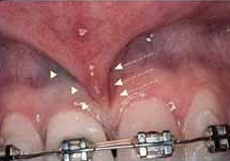
The dense band of tissue between the front teeth is called a frenum. When the frenum attaches close to the teeth, it can cause the teeth to separate even if braces have brought the teeth together. The teeth are more susceptible to gum disease, as the seal between the teeth and the gum can be disrupted when the frenum moves.
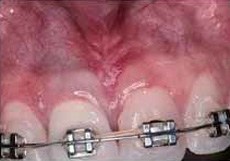
After a frenectomy is done to remove the excess tissue, there is no longer a dense band of tissue driving the teeth apart. The position of the teeth will be much more stable after braces are removed, and the patient’s periodontal condition will be more stable as well.
Long Island, NY Periodontal Reconstruction
ADDRESS:
98 East Main Street
Babylon, NY 11702
Get Directions
PHONE: (631) 661-6633
OFFICE HOURS:
- Monday: 11:00 AM to 8:00 PM
- Tuesday: 9:00 AM to 8:00 PM
- Wednesday: 8:00 AM to 5:00 PM
- Thursday: 8:00 AM to 5:00 PM
- Friday: 8:00 AM to 5:00 PM

